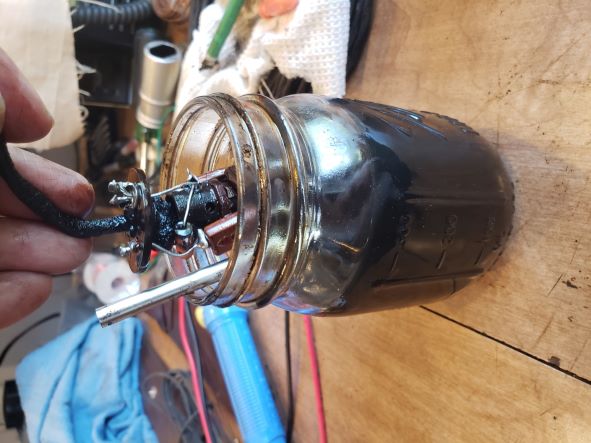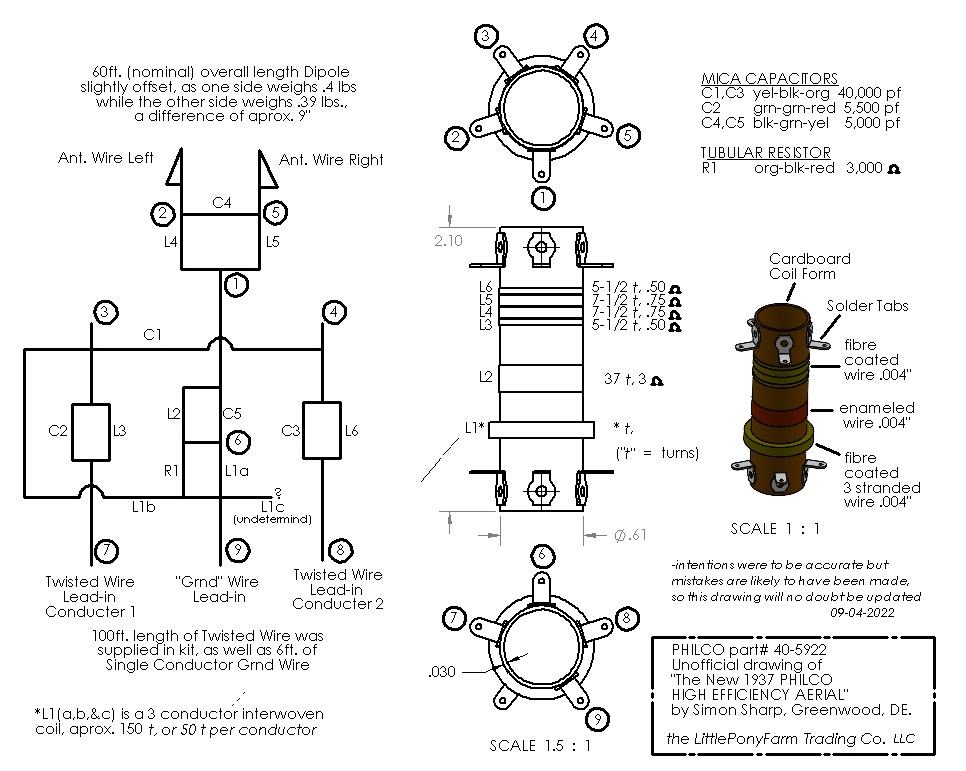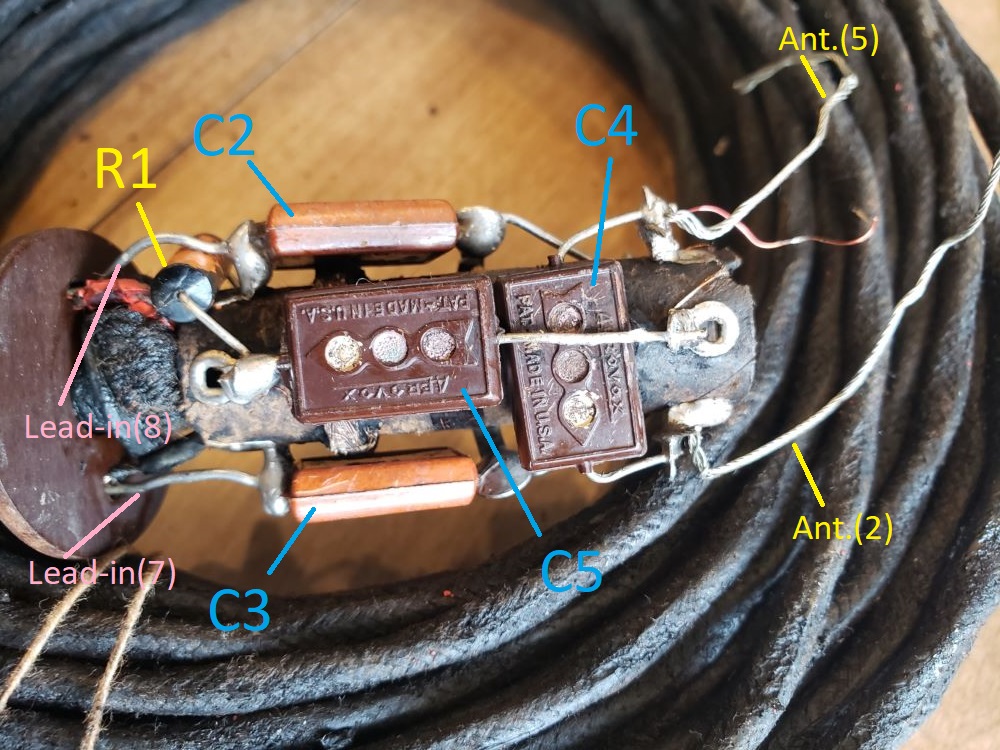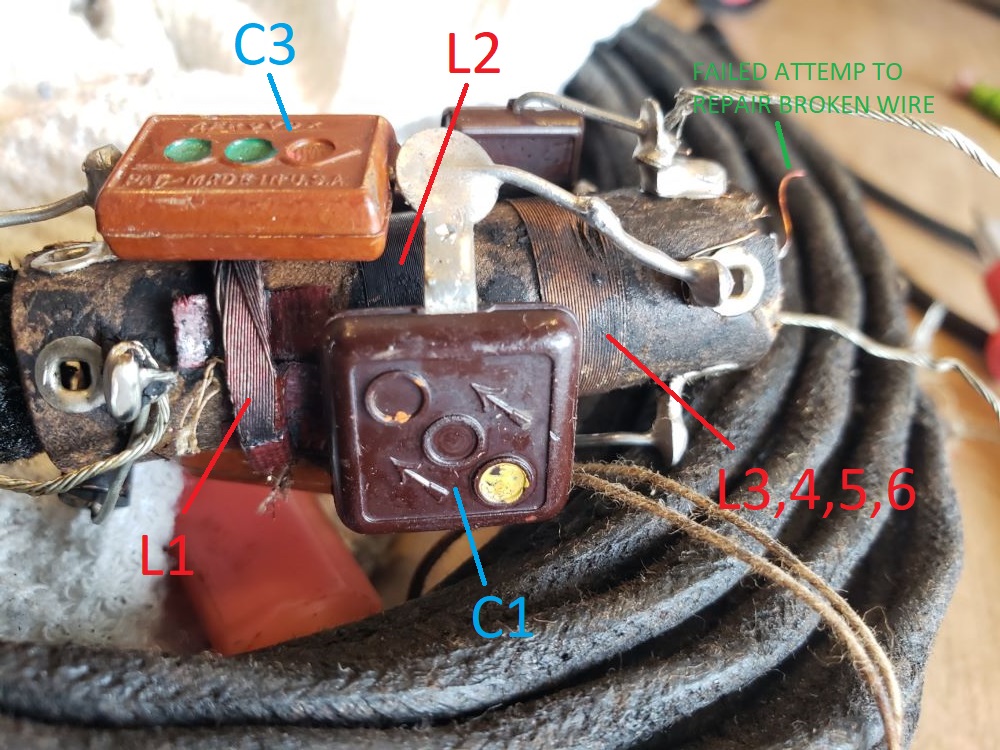Posts: 713
Threads: 8
Joined: Apr 2018
City: S. Dartmouth
State, Province, Country: MA
Mineral spirits should dissolve away the pitch and wax slowly but leave any paint code dots or coil sealants intact.
By description, seems the contents is a pair of tuned loading coils to broaden the response of each leg of the antenna wire.
It is also possible that there are resonances setup for the shortwave bands, popular and solar active at the time. Reviewing the solar cycle activity charts of that era may reveal that shortwave radios were built to favor those band openings.
Pliny the younger
“nihil novum nihil varium nihil quod non semel spectasse sufficiat”
Posts: 2,139
Threads: 158
Joined: Jan 2013
City: Westland, MI
Hello Simon. To answer the question about making changes (#40) after posting. The answer is yes. After signing in, go to the post you want to correct. At the bottom of the post is an Edit bar. Click on that, go to quick edit, make your changes, then hit save changes.
As far as the lightning strike question, does anything really survive a lightning strike? And even if it didn't look like any damage was done, I sure wouldn't trust it until completely checking it first.
Since you don't want to try a toaster oven and "Cooking with Ron", perhaps a heat gun could soften the tar enough to help remove it.
I've rambled enough. Take care and BE HEALTHY! Gary
"Don't pity the dead, pity the living, above all, those living without love."
Professor Albus Dumbledore
Gary - Westland Michigan
Posts: 68
Threads: 12
Joined: Jul 2021
City: poulsbo
State, Province, Country: Washington
Sign me up for what really is in that "PHILCO HIGH-EFFICIENCY AERIAL".
Thanks
Bill
Posts: 337
Threads: 13
Joined: Apr 2019
City: Greenwood
State, Province, Country: Delaware
All good advice, very smart bunch here; I don't have a toaster oven but am using heat gun to soften...they seem to be mica condensers, and some of the paint dots are already history but I should be able to measure them when I lift one of the legs...I still hold down a full time job but still time for fun!
-Simon
Oh, and I think Chas is right; there also seems to be a bigger coil down in there, too......
(This post was last modified: 08-08-2022, 12:46 PM by Simon Wa3uay.)
Posts: 713
Threads: 8
Joined: Apr 2018
City: S. Dartmouth
State, Province, Country: MA
My theory, without consulting my files full or antenna documentation I have. Is that the Philco antenna as well as antennas marketed by other radio manufactures during the "heyday" of shortwave. Are, aperiodic, such an "antenna" will have a high feedpoint impedance and wont match any feedline. So such feedpoint devices suit that purpose. What cannot be discounted that the "action" of the match system may include using the feedline as part of the reception as a vertical component. At certain times of the day and at lower wavelengths the short range of ground signal is very dominant. IMHO the antenna will be a compromise, that is not bad as a resonant antenna performs poorly off resonance.
Interestingly, RCA had an antenna FWIR called a "Spider-Web" I may be wrong in the terms but it looks a lot like the lower half of a spider web. What I believe it does with wire and a Delta match is to achieve a certain "broadbandedness" as well.
Such broadband, well, multi-band antennas are being built today, wire construction, awkward to hang and not at all stealth but they are resonant and matched to coax feedline for use with a transmitter. I salvaged at least two of these and did have one hung long ago. The other from an estate in 2007 I have rolled up in storage. I think it is a commercial unit or one that someone has put considerable labor into. Both these antenna are copper-weld wire, very strong because of the weight of the entire antenna system.
A word Simon:
Avoid manipulating the mica condensers by twisting, the clip the attaches the wire to the stack of metal plates can partially open and disconnect, making the cap go lower in capacity.
Good Work!
Chas
Pliny the younger
“nihil novum nihil varium nihil quod non semel spectasse sufficiat”
Posts: 337
Threads: 13
Joined: Apr 2019
City: Greenwood
State, Province, Country: Delaware
Lest ye think I've been slacking, we have been soaking this thing in a jar of mineral spirits, and it's just about clean now -even the interior which was plugged up
We have broken some one the fine magnet wire the tar was stuck to, but maybe we can count the turns....

actually, I have been slacking.
Posts: 1,258
Threads: 32
Joined: Jan 2014
City: Wellborn Florida
One has to wonder if their was a connection between Philco and one of the oil companies the way Philco like to coat things with tar!
Posts: 337
Threads: 13
Joined: Apr 2019
City: Greenwood
State, Province, Country: Delaware
Sept 4
We are finished with this (for now), and I haven’t made sense to how all these little tuned circuits are supposed to work together to make a “noise reducing” “More than double the number of stations you can get and enjoy” signal measured in microvolts. There must be some magic in the coils that are in series (L3,L4,L5,L6), plus the “Grnd” lead-in adds its own flavoring.
L1c, I could not find a termination. I broke 4 or 5 wires getting the tar off, and the Mica’s don’t measure right after being soaked and moved around.
Haven’t had this much fun since I slipped and twisted my knee while running in the rain with my arms full of tomatoes from the garden 10 years ago, the tomatoes were ok.
Simon



Posts: 344
Threads: 38
Joined: Jun 2011
City: Tustin
State, Province, Country: California
Posts: 13,776
Threads: 580
Joined: Sep 2005
City: Ferdinand
State, Province, Country: Indiana
Simon,
Thank you for all the work you have done thus far in trying to take the "mystery" out of the Philco High Efficiency Aerial. I hope your experiments will eventually lead to a successful conclusion. 
--
Ron Ramirez
Ferdinand IN
Posts: 13,776
Threads: 580
Joined: Sep 2005
City: Ferdinand
State, Province, Country: Indiana
thirtiesradio
Man, those Wellbrook loops are expensive! 
--
Ron Ramirez
Ferdinand IN
Posts: 344
Threads: 38
Joined: Jun 2011
City: Tustin
State, Province, Country: California
Hi Ron,
Yes they are expensive new. I have only bought one new as I wanted the low noise version. The other 3 I bought as I found them for under $150 each locally.
They are the best I've found at reducing local noise. I can almost completely null it out.
Posts: 337
Threads: 13
Joined: Apr 2019
City: Greenwood
State, Province, Country: Delaware
Thank you all; I suspect the old Philco "aerials" nulled out certain known (at the time) interfering frequencies with all those little resonant circuits, thereby making it "noise-reducing", I don't know. Yes, antennas can get expensive, but they are important because they are the 'first stage' of the radio preceding the amplifier or first detector and tuned properly can hear (and transmit) around the world!
Regards,
Simon
Posts: 2,139
Threads: 158
Joined: Jan 2013
City: Westland, MI
Excellent work, Simon! Now, when do you think you can start mass-producing them? (just kidding!) Take care and BE HEALTHY! Gary
"Don't pity the dead, pity the living, above all, those living without love."
Professor Albus Dumbledore
Gary - Westland Michigan
Posts: 337
Threads: 13
Joined: Apr 2019
City: Greenwood
State, Province, Country: Delaware
Gary, I will leave that up to you!
Simon
Users browsing this thread: 1 Guest(s)
|
|
Recent Posts
|
|
Need Help to ID this radio 11 tube Philco
|
| Yes the 16B as morzh pointed out. Specifically its the January 1935 model version of the 16B. There are a couple earli...klondike98 — 11:51 PM |
|
48-482 rear panel help
|
| Welcome to the Phorum, keithchip! How far you take a radio on cabinet restoration is a matter of personal preference. ...GarySP — 11:28 PM |
|
48-482 rear panel help
|
| I've recently finished the internal restoration of a locally purchased Philco 48-482. The cabinet is in ok shape except ...keithchip — 10:28 PM |
|
Need Help to ID this radio 11 tube Philco
|
| Welcome to the Phorum, Ken! Lots of help here for all of your restoration questions. Take care and BE HEALTHY! - Gar...GarySP — 07:59 PM |
|
Need Help to ID this radio 11 tube Philco
|
| Thank you.
I went to your online library and found 2 schematics.
I will download and compare to components!Ken D. — 06:31 PM |
|
Need Help to ID this radio 11 tube Philco
|
| It is a 16B tombstone.morzh — 06:13 PM |
|
Zenith H725
|
| David - sorry, I reread your post and finally saw THD - now the % figures make sense. Thanks for explaining.
The PSU...EdHolland — 06:06 PM |
|
Need Help to ID this radio 11 tube Philco
|
| Hi Everyone,
New member but have been reading this for awhile for tips!
Vaccum tubes were before my time so bear with ...Ken D. — 06:03 PM |
|
My Philco 37-116 Restore
|
| Thank you MrFixR55, I appreciate your comments very much. I do not detect much hum if any so I will be staying with the ...dconant — 05:15 PM |
|
My Philco 37-116 Restore
|
| Hi DConant
Yes, you can replace chokes with resistors. You do stand the risk of increased hum. the solution is to inc...MrFixr55 — 04:23 PM |
|
Who's Online
|
| There are currently no members online. |

|
 
|



![[-] [-]](https://philcoradio.com/phorum/images/bootbb/collapse.png)


